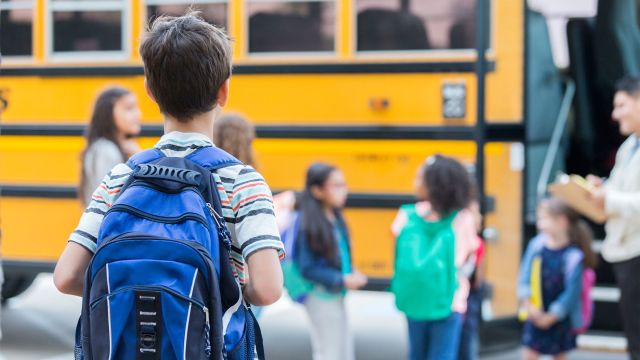Updated on April 1, 2025.
It’s that time again: a brand-new school year. For many kids, that means different teachers, unfamiliar classmates, mounds of fresh homework—and lots of anxiety.
Andrew Gunter, MD, a pediatrician in Greenville, South Carolina, compares the first day to starting a new job. “It can be stressful. You don’t know what to expect or who your boss is going to be,” he says. “Those are natural fears.”
The unknown isn’t the only drawback, either. After a long, lazy summer, kids can be thrown off their routines, which can worsen their apprehension. Getting back on track can be tough if you’re not prepared.
So, what can parents and guardians do to ease those back-to-school jitters? How can you make reacclimating as painless as possible? And when is a child's stress something more serious? Here what to know.
Anticipate and address kids’ fears
Whether they’re on edge about making friends, encountering bullies, or getting good grades, the first step to helping a stressed-out student is to get them talking.
“A conversation is always a good start,” says Dr. Gunter. “Ask your kid, ‘Are you worried about anything?’”
Then, listen to their concerns and validate their feelings. Assure them that their anxiety is completely normal and that they’re not alone.
“Let them that know you had those same fears,” advises Gunter. “It’s very comforting when you have someone who sits with you and says, ‘I went through the same thing.’” Remind your child, too, that as time goes on, these angst-inducing experiences will become part of a familiar routine.
The good news: School districts are often open over the summer to address student needs. So, if your child is attending a new school, visit it together before the year begins to get acquainted with classrooms, playgrounds, and teachers. Make it a priority to attend orientation sessions and ask if the school has a “buddy” program to help younger kids get comfortable. Plan out your routes to school, whether your child is walking, biking, or riding the bus.
Along with assuaging their fears, it also helps to stoke kids’ enthusiasm for the coming year.
“Make it fun to go back,” says Gunter. Talk up the positives, like learning about subjects they love and seeing old buddies. Involve them in shopping for clothes or school supplies, letting them choose pencils, notebooks, and a backpack for themselves.
You might also tease the opportunity to try different afterschool activities. From the school band to a community soccer league, getting involved in extracurriculars can help your child make new friends, develop their skills, “and see what piques their interest,” says Gunter.
Create healthy routines
To ease your child’s mind during those first days, establish a reliable routine that prioritizes healthy, stress-reducing habits. This can include a range of practices, from the simple—like laying out clothes the night before school—to bigger changes, such as designating times for certain activities. These can include the following:
Prioritize sleep
Experts recommend that children ages 6 to 13 sleep between 9 and 11 hours per night. Not getting enough is linked to a higher risk of academic problems and behavioral issues.
As the summer wanes, Gunter advises moving bedtime up in increments of about 15 minutes per night, starting at least a week before school begins. Begin setting the morning alarm a little earlier each day, as well. This way, he says, “it’s not a last-minute thing, which of course they’ll fight back on.”
Creating a consistent evening schedule may also smooth the way to new bedtimes. Nighttime use of electronic devices can lead to poor sleep, so turn off all gadgets—including TVs, smartphones, tablets, and video games—at least 60 minutes before bed. During quiet time, have them brush their teeth, shower, and read to help settle down.
Build in time for homework
For many young students, homework is a significant source of post-summer stress. Working around afterschool activities as best you can, block off a time for your child to complete their tasks each day—preferably in a quiet, uncluttered place, like the kitchen table or a home-office desk. Unless their homework requires a computer, make sure screens are turned off to reduce distraction.
If you’re present, never do your child’s homework for them. Instead, provide support, motivation, and snacks, as needed. If your child has difficulty with organization, a planner or dry-erase board can help everyone keep track of test dates, assignments, and extracurriculars.
Eat right
Help kids focus and gear up for each day with a wholesome breakfast. Choose foods low in added sugars, but with plenty of protein, fiber, and healthy fats for lasting energy. Scrambled eggs, low-fat yogurt, fruit, or whole-grain toast or waffles with peanut butter are easy options.
For lunch, make it a habit to pack healthy meals at night or have kids buy at school; many districts allow you to maintain an account online. Millions of families are eligible for a nutritious, low- or no-cost breakfast and lunch, as well. Check with your school for more information.
Exercise
Physical activity can help elementary schoolers relax and concentrate. Experts recommend children 6 years and older get at least 60 minutes of moderate-to-vigorous activity daily. Organized sports, playing outside with friends, or visiting the local playground is often enough to do the trick.
Get organized
Parents and guardians can help kids relax if they’re relaxed themselves. That means getting thing in order well before the first school bell rings. Try to schedule necessary physical exams and vaccinations earlier in the summer, since pediatricians’ offices can get quite busy come August.
“The week before school, everybody needs school physicals,” says Gunter. “There’s a massive push at the end of summer to get all this done.”
For children with health conditions like asthma or food allergies, make sure their teachers and the school nurse are aware ahead of time. The nurse should know when and how to administer medications. Take care to fill out related health and emergency contact forms, too.
If you have a child with a 504 plan or an individualized education program (IEP), you’ll want to confirm teachers, schedules, and accommodations for the new year, especially if you’ve moved or switched schools. It’s a good idea to send copies of the IEP to relevant personnel, too, and to ensure your child understands their provided services.
Consider when it’s more than butterflies
Sometimes, a child’s back-to-school distress goes beyond typical jitters. “What happens in some kids is they start having more worry and more fear, and that fear then leads to true anxiety,” Gunter says. “You’ll see this progressive resistance to school—more and more tears as opposed to fewer and fewer.”
Although the worst of the social disruption caused by the COVID-19 pandemic is over, the experience has taken a significant toll on the mental health of many kids. Isolation, interrupted services, and health fears contributed to higher levels of unhappiness, anxiety, and depression—and strained the resources that typically offer help. These effects may be felt for years to come.
If your child’s back-to-school struggles are worsening, or if they’re having physical issues linked to stress, like stomachaches or headaches, reach out to your child’s healthcare provider (HCP). A pediatrician’s job, says Gunter, “is to reassure the parent or give them tips to help their child overcome this.” HCPs can also help diagnose something more serious, he adds, like depression or anxiety, and get kids the support they need. You can also speak with a teacher, counselor, or administrator to learn more about your school’s mental health resources.
Ultimately, while a new school year may stoke some truly understandable fears, addressing those worries head-on and encouraging good habits can help ease the end-of-summer transition—both for your child and you.







